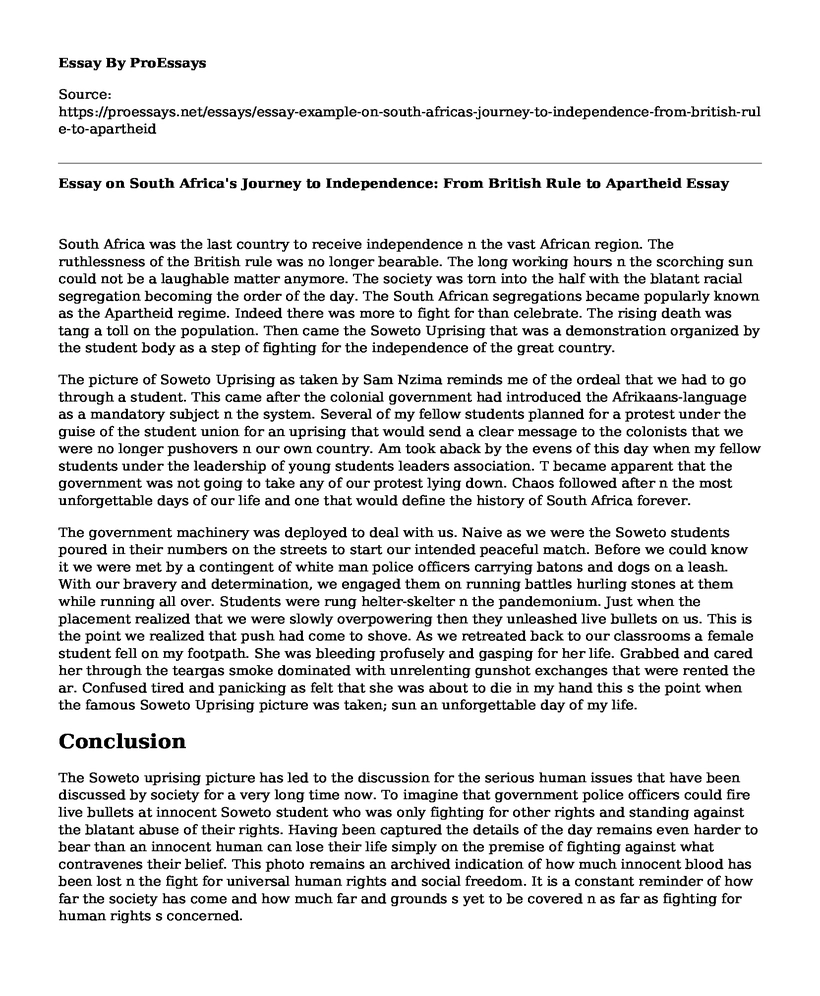South Africa was the last country to receive independence n the vast African region. The ruthlessness of the British rule was no longer bearable. The long working hours n the scorching sun could not be a laughable matter anymore. The society was torn into the half with the blatant racial segregation becoming the order of the day. The South African segregations became popularly known as the Apartheid regime. Indeed there was more to fight for than celebrate. The rising death was tang a toll on the population. Then came the Soweto Uprising that was a demonstration organized by the student body as a step of fighting for the independence of the great country.
The picture of Soweto Uprising as taken by Sam Nzima reminds me of the ordeal that we had to go through a student. This came after the colonial government had introduced the Afrikaans-language as a mandatory subject n the system. Several of my fellow students planned for a protest under the guise of the student union for an uprising that would send a clear message to the colonists that we were no longer pushovers n our own country. Am took aback by the evens of this day when my fellow students under the leadership of young students leaders association. T became apparent that the government was not going to take any of our protest lying down. Chaos followed after n the most unforgettable days of our life and one that would define the history of South Africa forever.
The government machinery was deployed to deal with us. Naive as we were the Soweto students poured in their numbers on the streets to start our intended peaceful match. Before we could know it we were met by a contingent of white man police officers carrying batons and dogs on a leash. With our bravery and determination, we engaged them on running battles hurling stones at them while running all over. Students were rung helter-skelter n the pandemonium. Just when the placement realized that we were slowly overpowering then they unleashed live bullets on us. This is the point we realized that push had come to shove. As we retreated back to our classrooms a female student fell on my footpath. She was bleeding profusely and gasping for her life. Grabbed and cared her through the teargas smoke dominated with unrelenting gunshot exchanges that were rented the ar. Confused tired and panicking as felt that she was about to die in my hand this s the point when the famous Soweto Uprising picture was taken; sun an unforgettable day of my life.
Conclusion
The Soweto uprising picture has led to the discussion for the serious human issues that have been discussed by society for a very long time now. To imagine that government police officers could fire live bullets at innocent Soweto student who was only fighting for other rights and standing against the blatant abuse of their rights. Having been captured the details of the day remains even harder to bear than an innocent human can lose their life simply on the premise of fighting against what contravenes their belief. This photo remains an archived indication of how much innocent blood has been lost n the fight for universal human rights and social freedom. It is a constant reminder of how far the society has come and how much far and grounds s yet to be covered n as far as fighting for human rights s concerned.
Cite this page
Essay on South Africa's Journey to Independence: From British Rule to Apartheid. (2023, Jan 16). Retrieved from https://proessays.net/essays/essay-example-on-south-africas-journey-to-independence-from-british-rule-to-apartheid
If you are the original author of this essay and no longer wish to have it published on the ProEssays website, please click below to request its removal:
- Why Texas Should Not Lower the Drinking Age Essay
- Mass Incarceration in the Land of Freedom Paper Example
- The Surge of Nationalism: Race, Nationalism, and War Essay Example
- U.S. Becomes More Open, Tolerant, and Free in the 1960s - Essay Sample
- Essay Sample on Conflict in Syria: Global Humanitarian Crisis & Threat to International Community
- Unique American Culture: Religion & Belief Tolerance - Essay Sample
- Essay Sample on Exploring Egypt's Ancient Art & Architecture: A Historical Journey







